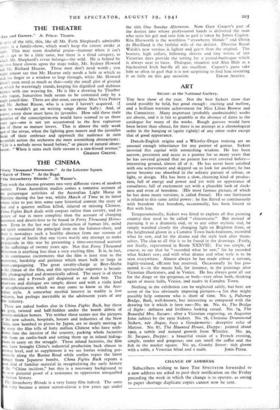ART
Sickert at the National Gallery.
THE best show of the year. Not the best Sickert show that could possibly be held, but good enough : exciting and mellow, and a brilliant wartime achievement for Miss Lilian Browse and the Committee. Many important (probably unobtainable) works are absent, and it is fair to grumble at the absence of dates in the catalogue for many of the works. Rough guesses would have been better than silence, for there is no attempt at a chronological order in the hanging or (quite rightly) of any other order except that of good appearance.
Danish-English origins and a Whistler-Degas training are an unusual enough inheritance for any painter of genius. Sickert invested this capital with astonishing wisdom. He has been narrow, persistent and acute as a painter for so many years that he has covered ground that no painter has ever covered before— interesting ground, almost all of it. He has never been satisfied with one achievement and skipped on to look for another; he has never become too absorbed in the solitary pursuit of colour, or light, or design. His has been a slow, churning kind of produc- tion, full of energy and power and yet with an appearance of casualness; full of excitement yet with a plausible look of slack- ness and even of boredom. (His most famous picture, of which he has done many versions, is called Ennui). His one limitation is related to this same artful power: he has flirted so continuously with boredom that boredom, occasionally, has been forced to flirt with him.
Temperamentally, Sickert was fitted to explore all that painting tR country that used to be called " chiaroscuro." But instead of pursuing it to a dramatic. end, or to any other stylistic end, he simply watched closely the changing light on Brighton front, or the heightened gloom in a Camden Town back-bedroom, recorded what he saw, and let the drama and the style look after them- selVes. The clue to all this is to be found in the drawings. (Fairly, not finally, represented in Room )(XXVII). Far too simple, of course, to say that he " recorded what he saw," for he recorded what Sickert saw; and with what drama and what style is to be seen everywhere. Almost always he has made colour a servant, highly-trained, efficient but reserved. Occasionally he has pro- moted it—in the music "hall, for instance, in the paintings after Victorian illustrators, and in Venice. He has always gone all out for the dingy or the gorgeous, or both—very often both, thinking again of music halls, Venice, and nudes in Camden Town.
Nothing in the exhibition can be neglected safely, but here are seven of the less obviously imposing pictures—a list that might possibly help someone who is short of time. No. 3, Pulteney Bridge, Bath, well-known, but interesting as compared with the drawing for it which is here too—No. 99. No. 61, The Bridge of Sighs: deftness and liveliness looking casual. No. 74, The Beautiful Mrs. Swears: after a Victorian engraving, an Augustus John subject by the 1930 Sickert. No. 78, Christine Drummond Sickert, née Angus, buys a Gendarmerie: deceptive echo of Matisse. No. 87, The Haunted House, Dieppe: painted about 1902, a subtle and natural growth from Whistler. No. 90, St. Jacques, Dieppe: a beautiful vision of a French evening, simple, tender and gorgeous; one can smell the coffee and the fish in the market square. No. 95, Granby Street: rich gloom with a table, a Venetian blind and a nude. JoHN PIPER.


































 Previous page
Previous page